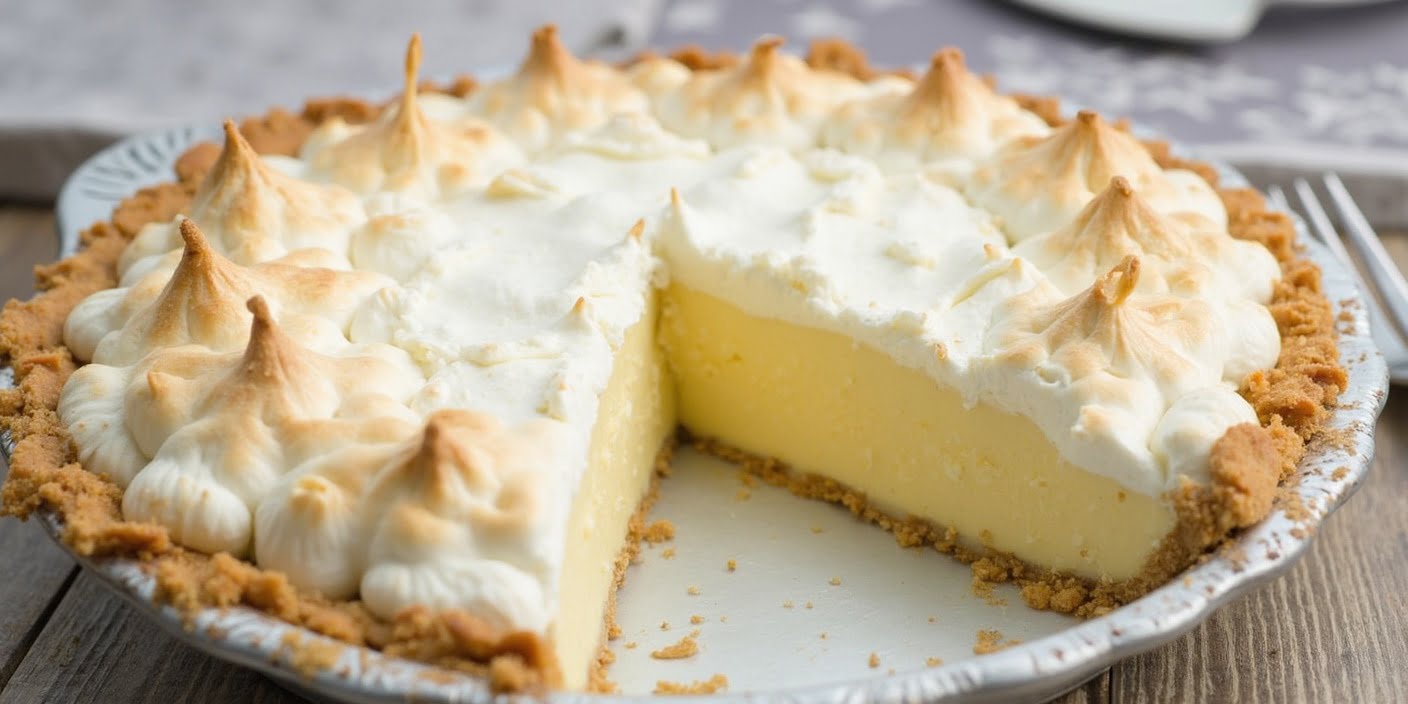There’s something special about a coconut meringue pie. It’s a classic dessert that blends the sweet, creamy coconut filling with a light, fluffy meringue topping, all held together by a buttery, flaky homemade crust. Whether it’s a family gathering, holiday celebration, or just because you’re craving something indulgent, this pie is the perfect dessert. The texture of the creamy filling, combined with the airy meringue, offers a delightful contrast that’s hard to resist.
In this article, we’ll walk through a step-by-step guide on how to make easy coconut meringue pie with a homemade crust. Whether you’re a seasoned baker or a beginner, this guide will provide all the details you need to succeed.
Ingredients for Coconut Meringue Pie
This recipe consists of three main components: the crust, the coconut filling, and the meringue topping. Each layer brings a unique element to the pie, creating a perfectly balanced dessert.
For the Pie Crust:
- 1 1/4 cups all-purpose flour: This forms the base of your flaky crust.
- 1/2 cup unsalted butter (cold, cubed): Cold butter is key to a light, flaky crust.
- 1/4 teaspoon salt: Enhances the flavor of the crust.
- 3-4 tablespoons ice water: Helps bind the dough together.
For the Coconut Filling:
- 1 1/2 cups whole milk: Acts as the base for the creamy coconut filling.
- 1/2 cup sugar: Sweetens the filling.
- 1/3 cup cornstarch: Thickens the custard filling.
- 4 large egg yolks: Adds richness and helps to bind the filling.
- 1 tablespoon unsalted butter: Provides a smooth, rich texture.
- 1 cup shredded sweetened coconut: Brings in the tropical coconut flavor.
- 1 teaspoon vanilla extract: Adds flavor depth to the filling.
For the Meringue Topping:
- 4 large egg whites: Provides the light, fluffy meringue.
- 1/4 teaspoon cream of tartar: Stabilizes the meringue.
- 1/2 cup sugar: Sweetens and adds a glossy finish to the meringue.
Step-by-Step Guide to Make Coconut Meringue Pie
Follow these steps to create a classic coconut meringue pie that’s sure to impress everyone at the table.
Step 1: How to Make the Pie Crust
Making the perfect homemade crust is all about keeping the ingredients cold and not overworking the dough. Here’s how:
- Combine dry ingredients: In a medium bowl, whisk together the flour and salt.
- Add cold butter: Cut the cold butter into the flour using a pastry cutter or your fingers until the mixture resembles coarse crumbs.
- Add ice water: Gradually add 1 tablespoon of ice water at a time, mixing gently with a fork until the dough starts to come together.
- Chill the dough: Form the dough into a ball, wrap it in plastic wrap, and refrigerate for at least 30 minutes before rolling it out.
- Roll out the dough: On a floured surface, roll the dough into a circle to fit a 9-inch pie dish. Press the dough into the dish and trim any excess edges. Prick the bottom with a fork.
- Blind bake: Preheat the oven to 375°F (190°C). Line the pie crust with parchment paper and fill with pie weights or beans. Bake for 15 minutes, then remove the weights and bake for another 10 minutes until golden.
Step 2: Preparing the Coconut Filling
While the crust cools, you can start working on the coconut filling.
- Whisk dry ingredients: In a medium saucepan, whisk together the sugar and cornstarch.
- Cook the filling: Gradually whisk in the milk. Cook the mixture over medium heat, whisking constantly until it thickens and begins to bubble (about 5-7 minutes).
- Temper the eggs: In a separate bowl, whisk the egg yolks. Slowly add a small amount of the hot milk mixture to the yolks to temper them, then pour the yolk mixture back into the saucepan.
- Finish the filling: Continue cooking for another 2-3 minutes, stirring constantly, until the mixture becomes thick and smooth. Remove from heat and stir in the butter, shredded coconut, and vanilla extract.
- Pour into the crust: Pour the filling into the cooled pie crust and set aside.
Step 3: Whipping the Perfect Meringue
The meringue is what gives this pie its signature fluffy topping. Here’s how to make a perfect meringue:
- Beat the egg whites: In a clean, dry bowl, beat the egg whites and cream of tartar on medium speed until soft peaks form.
- Add sugar gradually: Gradually add sugar, 1 tablespoon at a time, beating until stiff peaks form and the meringue is glossy.
- Spread the meringue: Spread the meringue over the coconut filling, making sure to seal the edges to prevent shrinking.
- Bake: Bake the pie at 350°F (175°C) for 10-12 minutes, or until the meringue is golden brown. Allow the pie to cool before slicing.
Tips for Baking a Perfect Coconut Meringue Pie
- Seal the meringue properly: Make sure the meringue touches the edges of the crust to prevent it from shrinking as it bakes.
- Avoid overbeating the meringue: Overbeating can cause the meringue to break down and become grainy, so stop once stiff peaks form.
- Use fresh egg whites: Fresh eggs will give you a more stable meringue.
Flavor Variations and Add-ins
While the classic coconut meringue pie recipe is delightful on its own, here are a few ways to switch it up:
Adding Toasted Coconut to Elevate Flavor
Before adding the shredded coconut to the filling, toast it lightly in the oven for an extra depth of flavor. Toasted coconut adds a rich, nutty undertone to the pie.
Adding a Layer of Chocolate
For a decadent twist, spread a thin layer of melted dark chocolate on the bottom of the pie crust before adding the coconut filling. This will add a surprising burst of flavor that pairs beautifully with the coconut.
Serving Suggestions for Coconut Meringue Pie
Serve your creamy coconut meringue pie with some delightful pairings to make the dessert experience even better:
- Top with whipped cream: A dollop of freshly whipped cream adds an extra layer of creaminess.
- Serve with fresh fruit: Fresh raspberries, blueberries, or strawberries provide a tart contrast to the sweet pie.
- Pair with a tropical drink: Coconut pie pairs wonderfully with a coconut-flavored cocktail or a fruity iced tea.
Storing and Reheating Coconut Meringue Pie
Here’s how to store and reheat any leftover pie (if there is any!):
Storing
Cover the pie loosely with plastic wrap and store it in the refrigerator for up to 3 days. Avoid pressing down on the meringue to keep it fluffy.
Reheating
Meringue pies are best served fresh, but if needed, you can warm slices in a 300°F oven for 5-10 minutes.
Conclusion: Why Coconut Meringue Pie Is a Dessert Staple
Coconut meringue pie is the perfect dessert for any occasion. Its balance of creamy coconut filling and airy meringue topping makes it a crowd-pleaser every time. Whether you’re celebrating a special occasion or just indulging in a sweet treat, this pie is guaranteed to impress.
For more dessert inspiration, check out this easy lemon bundt cake recipe for another show-stopping dessert idea.
FAQs About Coconut Meringue Pie
- Can I use a store-bought crust for coconut meringue pie?
Yes, if you’re short on time, a store-bought pie crust will work just fine. - Can I make coconut meringue pie ahead of time?
Yes, you can make it a day ahead, but it’s best served the same day to keep the meringue fluffy. - How do I prevent the meringue from weeping?
Sealing the meringue to the edges of the pie crust helps prevent weeping. Also, be sure to bake the meringue until fully set. - Can I use unsweetened coconut for the filling?
Yes, but the filling will be less sweet. You may want to add a bit more sugar to compensate. - Can I freeze coconut meringue pie?
Freezing is not recommended as the meringue can become watery when thawed. - What is the best way to toast coconut?
Spread shredded coconut on a baking sheet and toast in a 350°F oven for 5-7 minutes, stirring occasionally. - Can I use a different type of crust?
Absolutely! A graham cracker or shortbread crust can also complement the flavors of the pie. - How can I make this pie dairy-free?
Use coconut milk instead of whole milk, and substitute dairy-free butter for the crust and filling.

